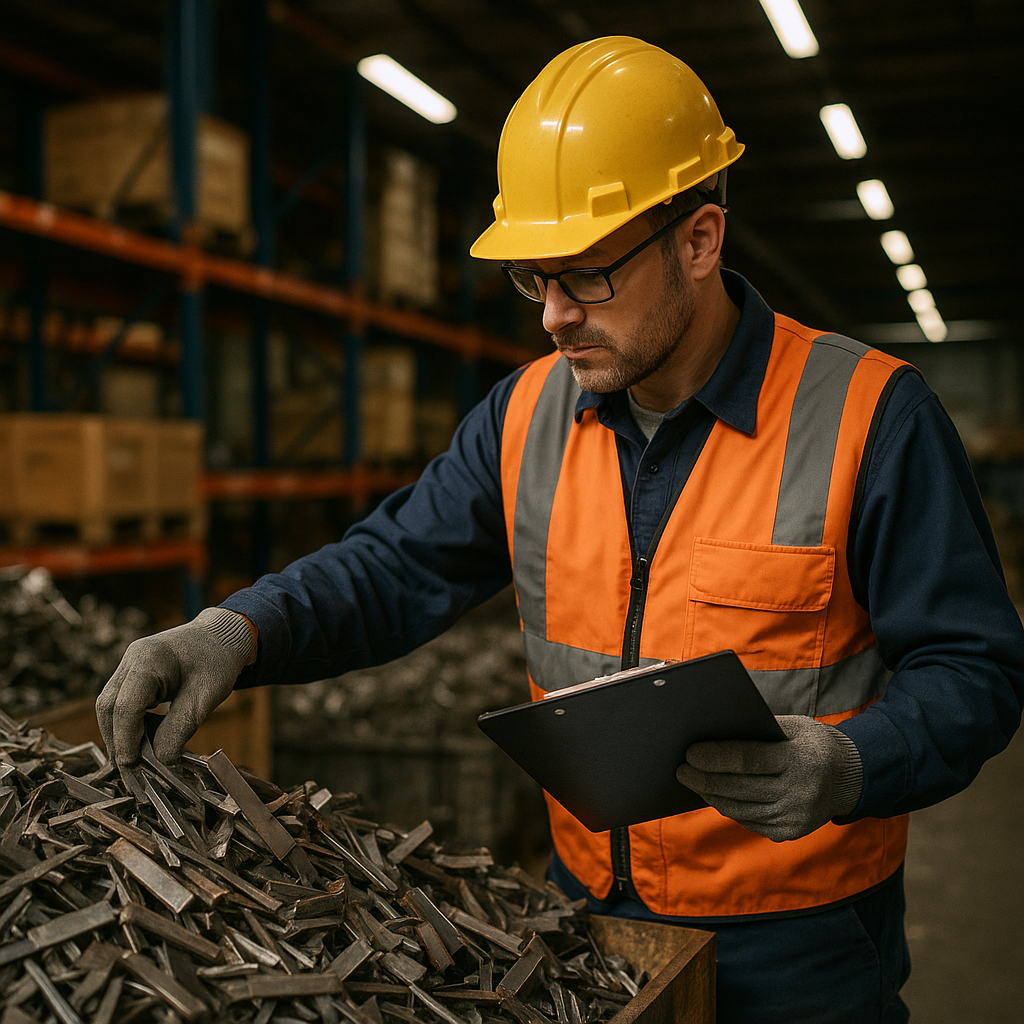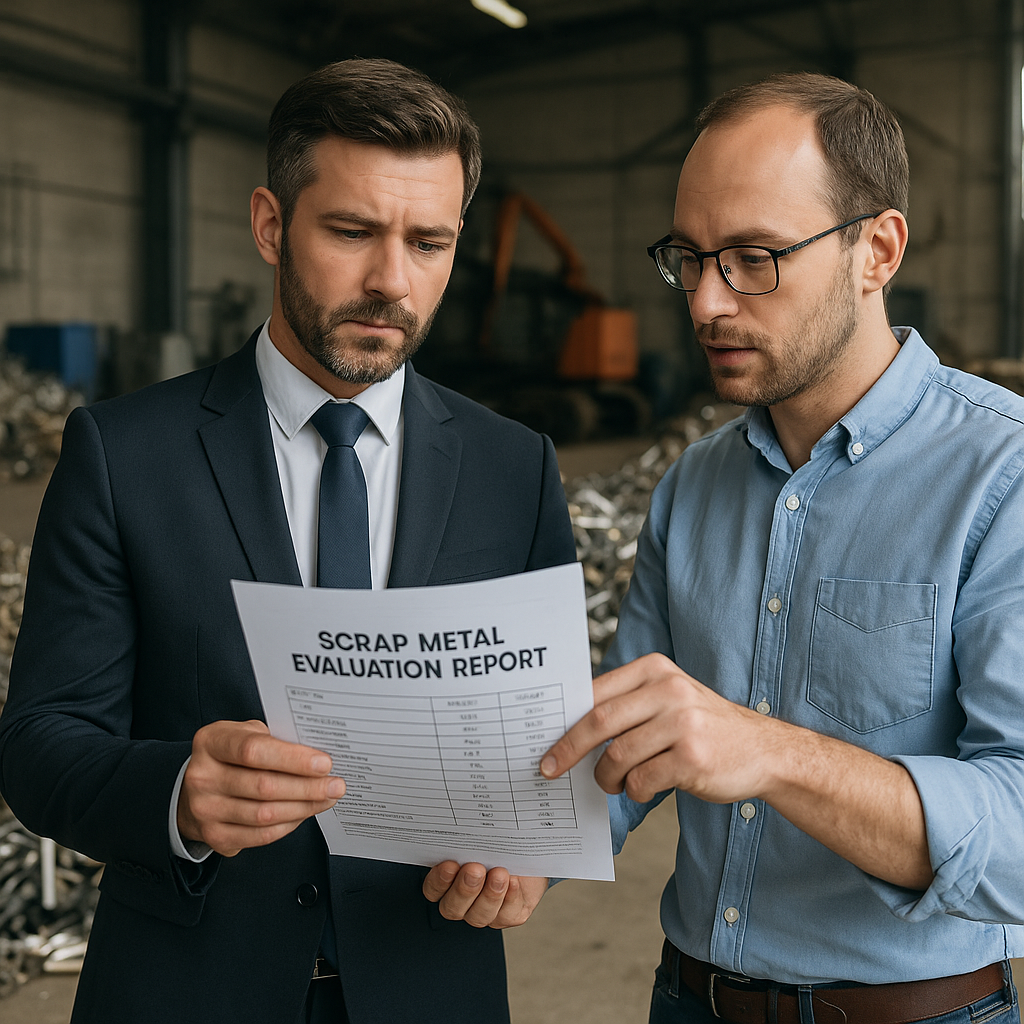5901 Botham Jean Blvd, Dallas, TX 75215
Scrap Metal Audit: A Complete Guide to the Process & Maximizing Value
October 27, 2025A scrap metal audit is a formal examination of a business’s recycling processes for discarded metal, retired electronics, and old machinery. The audit evaluates how your company handles metal waste to identify inefficiencies and missed opportunities in your recycling strategy.
Every year, businesses discard valuable metals, often unaware of their worth. Many simply add these materials to standard waste streams, foregoing potential savings and missing the opportunity to reduce their environmental impact. A proper scrap metal audit can transform this wasteful approach.
The benefits of conducting a scrap metal audit are twofold. It maximizes financial returns by identifying valuable metals for recycling instead of disposal. It also significantly reduces environmental impact by keeping recyclable materials out of landfills and lessening the need for new metal mining. According to the Institute of Scrap Recycling Industries, metal recycling can cut greenhouse gas emissions by up to 300 million tons each year.
How Do You Prepare for a Scrap Metal Audit?

Understanding the metal recycling process is essential for conducting an effective scrap audit. Before starting your audit, familiarize yourself with how metals are sorted by type, cleaned of contaminants, and processed at recycling facilities. This knowledge helps you prepare your scrap properly before sending it to recyclers.
Getting your team involved is crucial for audit success. Assign clear roles to different team members to enhance accountability. Form small groups with specific responsibilities: one team collects metal, another sorts materials, while a third handles inventory tracking. Brief training sessions ensure everyone understands their roles and the audit’s goals.
Establishing a regular scrap inventory check system is vital. Determine the frequency of checks based on your operation size and scrap volume. Smaller businesses might conduct quarterly checks, while larger operations with high scrap output may require monthly reviews. Document each check thoroughly using consistent measurement methods.
Proper preparation also involves having the right tools and equipment. Equip your team with essential items like gloves, sorting containers, and reliable scales. Safe handling practices not only reduce injury risks but also ensure accurate material sorting.
Create clear documentation procedures to track scrap metal from collection to recycling. Use standardized forms to record material types, weights, and storage locations. This documentation is invaluable when analyzing the effectiveness of your recycling program.
Plan your storage strategy carefully to maintain scrap value. Store metals in dry, organized areas to prevent rust and contamination. Separate ferrous from non-ferrous metals using simple magnetic tests — ferrous metals attract magnets while non-ferrous do not. This separation maximizes recycling value.
Lastly, establish baseline metrics to measure improvement over time. Track key indicators like total scrap weight, recycling rates, and contamination levels. These benchmarks enable you to quantify progress and identify areas needing attention in future audit cycles.
| Role | Responsibilities |
|---|---|
| Team Manager | Leads the audit, ensures staff are trained, organizes, and oversees the audit. |
| Waste Sorter | Sorts and separates scrap metals into categories for weighing and tracking. |
| Waste Weigher | Weighs the separated metals and coordinates with the data recorder to document weights. |
| Data Recorder | Keeps accurate records of scrap metal quantities and types sorted, and reports findings. |
What Are the Key Steps in the Scrap Metal Auditing Process?

An effective scrap metal audit follows a systematic approach to identify, document, and enhance the value of recyclable metals in your facility. Adopting these key steps will ensure a thorough assessment and profitable recovery.
- Sort metals into ferrous and non-ferrous categories – Start by using a magnet to distinguish ferrous metals (containing iron) from non-ferrous metals. This essential sorting technique immediately divides your scrap into two major categories and establishes the foundation for all metal sorting. Ferrous metals will adhere to the magnet, while non-ferrous metals like copper, aluminum, and brass won’t.
- Create detailed tracking documentation – Develop a comprehensive tracking sheet to record metal types, weights, conditions, and locations. This documentation ensures accountability throughout the process and helps quantify the potential value of recovered materials. Track information by department or area to identify which parts of your facility generate the most recyclable scrap.
- Conduct thorough facility inspections – Systematically examine all areas of your facility, including machinery rooms, storage spaces, and outdoor locations where metal might accumulate. Be particularly thorough in maintenance areas, equipment storage, and places where metals might be mixed with other materials.
- Categorize and identify metal types – Within your ferrous and non-ferrous categories, further identify specific metal types. Look for visual cues like color (copper is reddish-brown, aluminum is silver), weight (aluminum is lightweight while lead is heavy), and typical applications (brass is common in plumbing fixtures). For uncertain materials, consider using a small file to check the color beneath the surface.
- Prioritize removal of high-value metals – Organize your recovery efforts by initially focusing on the most profitable metals. Copper, brass, and aluminum generally command higher prices than steel or iron. Within these categories, clean materials without contaminants yield better returns.
- Plan for safe removal and transport – Develop protocols for safely removing, handling, and transporting different metal types. This includes providing proper safety equipment for workers, ensuring appropriate containers for different metal categories, and arranging efficient transport to recycling facilities.
Throughout the process, specialized tools can significantly improve accuracy and efficiency. Beyond magnets, consider investing in wire strippers for valuable copper wire, proper storage containers for different metal categories, and personal protective equipment for those handling the materials. Some facilities may benefit from portable metal analyzers for precise identification of alloys.
A well-executed scrap metal audit not only recovers valuable materials but also helps implement better ongoing practices for metal waste management. By documenting findings and establishing regular audit schedules, organizations can transform their approach to metal waste from disposal to valuable resource recovery.
| Classification Type | Characteristics | Examples |
|---|---|---|
| Ferrous Metals | Contains iron, usually magnetic, prone to rust | Steel, Cast Iron, Wrought Iron |
| Non-Ferrous Metals | Does not contain iron, not magnetic, high corrosion resistance | Aluminum, Copper, Brass, Zinc |
| Metal Alloys | Combination of metals, often to improve strength and resistance | Brass (Copper + Zinc), Bronze (Copper + Tin) |
| Precious Metals | High economic value, corrosion resistance, often used in jewelry | Gold, Silver, Platinum |
How Can You Maximize Value from Your Scrap Metal Audit?

Transforming your scrap metal audit findings into substantial financial returns requires strategic planning and execution. Proper handling techniques and informed business decisions can significantly boost the value of your scrap metal recycling program.
Proper Storage Solutions Protect Value
Proper storage is crucial in maximizing scrap metal value. Rusted or deteriorated metal can lose up to 40% of its worth. To prevent exposure to moisture and weather elements, store your scrap in dry, covered areas.
Consider these essential storage strategies for optimal value preservation:
- Keep scrap metal off the ground using pallets or containers.
- Store materials under a roof or use weatherproof coverings like tarps.
- Ensure your storage location allows easy access for fire control measures.
- Implement proper stormwater management to prevent environmental issues.
For businesses with limited indoor storage, investing in dedicated metal containers can provide necessary protection while keeping operations organized. This small investment can quickly pay for itself by preserving metal value.
Strategic Metal Sorting Increases Returns
Properly sorting metals before recycling can boost your returns by 20-30% compared to mixed loads. Start by using a strong magnet to identify ferrous (magnetic) and non-ferrous metals. Further separate materials by type and grade, keeping copper, aluminum, brass, and stainless steel in separate containers to maximize their value.
Remove contaminants before recycling. Strip insulation from copper wires, detach attachments from metal frames, and clean off paints or coatings when possible. These extra steps significantly increase the value recyclers can offer.
| Metal Type | Value When Sorted | Value When Unsorted |
|---|---|---|
| Copper | High | Moderate to Low |
| Aluminum | High | Lower |
| Brass | High | Moderate |
| Ferrous Metals (Steel, Iron) | Moderate | Low |
Timing and Quantity Considerations
Market timing and volume are critical for maximizing recycling returns. Monitor scrap metal market prices using resources like RecyclingToday or the Institute of Scrap Recycling Industries (ISRI) to identify favorable selling opportunities.
Accumulate larger quantities before recycling when possible. Many recyclers offer better rates for bulk materials as it reduces their processing and transportation costs relative to the value received. Smaller businesses might consider partnering with other local companies to combine shipments and negotiate better rates.
Selecting the Right Recycling Partner
Your choice of recycling partner directly impacts your bottom line. Research multiple scrap yards and compare their:
- Current price offerings for specific metal types
- Transportation and collection services
- Certification and compliance credentials
- Payment terms and methods
Establish relationships with reputable recyclers who provide transparent pricing and detailed reporting. These partnerships often lead to preferential treatment, educational resources for better sorting, and insider knowledge about market conditions.
Continuous Improvement Through Data Tracking
Implement a system to track the volumes, types, and values of scrap metal you recycle. This data provides valuable insights for optimizing your recycling program and measuring ROI.
Set specific KPIs such as revenue per ton, total tonnage diverted from waste, or cost savings over time. Regular analysis of these metrics reveals opportunities for process improvements and helps justify investments in better sorting equipment or storage solutions.
When combined with your scrap audit findings, this tracking system creates a continuous improvement cycle that maximizes value year after year from materials that might otherwise become waste.
Final Words
A scrap metal audit transforms waste management from a simple cost center into a significant revenue stream. By systematically preparing your team, implementing rigorous sorting and tracking, and strategically optimizing storage and partner relationships, you unlock the hidden financial value in discarded materials. This process not only boosts your bottom line but also reinforces your commitment to environmental sustainability, turning potential landfill waste into a valuable resource.
Ready to turn your scrap metal waste into a reliable revenue stream? Contact Okon Recycling at 214-717-4083 to schedule your professional audit.
